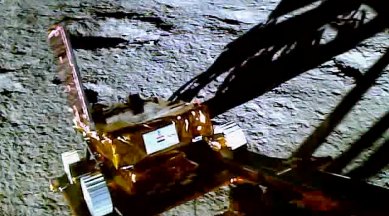Chandrayaan rover detects sulphur, other elements on Moon: ISRO
The presence of oxygen, calcium and iron has also been detected, the space agency informed

After releasing data from an instrument studying the temperature profile of the lunar surface, the Indian Space Research Organisation (ISRO) on Tuesday said another instrument on Chandrayaan-3 had detected the presence of several elements on the Moon.
Notably, it had picked up signals that confirm the presence of Sulphur whose direct evidence was not available yet.
monthly limit of free stories.
with an Express account.
“The Laser-Induced Breakdown Spectroscopy (LIBS) instrument onboard Chandrayaan-3 Rover has made the first-ever in-situ measurements on the elemental composition of the lunar surface near the South Pole. These in-situ measurements confirm the presence of Sulphur (S) in the region unambiguously, something that was not feasible by the instruments onboard the orbiters,” ISRO said in a statement.
“Preliminary analysis… have unveiled the presence of Aluminum (Al), Sulphur (S), Calcium (Ca), Iron (Fe), Chromium (Cr), and Titanium (Ti) on the lunar surface. Further measurements have revealed the presence of Manganese (Mn), Silicon (Si), and Oxygen (O). Thorough investigation regarding the presence of Hydrogen is underway,” it said.
Gathering information about the presence and abundance of different elements on the Moon is one of the major science objectives of the Chandrayaan-3 mission, with more than one instrument working towards this end. The LIBS instrument on the rover, developed by ISRO’s Laboratory for Electro-Optics Systems (LEOS), uses a high-energy pulsar to generate plasma from rocks or soil. In plasma state, elements emit characteristic wavelengths of radiation that can then be used to identify these elements, ISRO said.
The other instrument on the rover, called Alpha Particle X-Ray Spectrometer, is also meant to study the elemental composition of the lunar surface.
The elements detected by the LIBS instrument are all known to occur on the Moon. This data would add to the existing knowledge. For example, evidence of the presence of Sulphur can reveal insights on the formation and evolution of the Moon. Sulphur usually originates in volcanic activities, and its presence on the Moon can offer indications about the Moon’s history and composition.
“The data being put out by ISRO from Chandrayaan-3 needs to be processed and analysed to get more meaningful information. What ISRO is doing right now is to offer glimpses into the kind of experiments being performed on the Moon, and the nature of activities of the various instruments,” said Anil Bhardwaj, director of Ahmedabad-based Physical Research Laboratory which has made significant contributions to the Chandrayaan-3 mission, including the development of the ChaSTE (Chandra’s Surface Thermophysical Experiment) that is deployed on the lander module.
“For example, the data about surface temperatures that was released on Sunday was just a small snapshot of the readings being taken by that instrument ChaSTE. Those values would be different at different times. The instruments onboard Chandrayaan-3 are collecting a huge amount of data, making a number of observations, and doing several experiments at once. All this data is being relayed to the ground stations. Once the mission is over, scientists specialising in these areas would analyse these data thoroughly. Only then we would be able to tell what new or revelatory findings have come out from the mission,” he said.